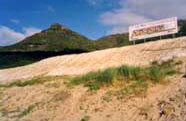|
|
|
Diversification |
|
|
GeoJute
- Jute for the Future
Jute - one of the oldest industries in India, has traditionally been
used for packaging. However its versatility is only coming
to light now as the world looks on for this natural fibre to take over
with the ideal solutions for the modern world. Be it in conserving
the soil and the environment. The time has come for this natural
fibre to take over with the ideal solutions for the modern
world. Be it in conserving the soil and themodern world. Be it
in conserving the soil and the environment or in
applications like civil engineering which are essential for the progress
of cultivation. |
|
| |
 |
Diversification of Jute
Fibres
|
| |

|
Jute Diversification
-NCJD
- Jute Service centres
|
| |
 |
Jute Fancy Bags
|
| |
 |
Jute
Based Handicrafts & Novelties
|
Jute Geotextiles comes in two varieties - woven and non-woven
fabrics. The distinguishing features that make it more eco-friendly
are
High moisture absorption
capacity Flexibility
Drainage Properties
GeoJute finds Application in -
|
|
| |
 |
Jute Based
Consumer Items
|
| |
 |
Geo Jute & Jute Geotextiles
|
| |
 |
ITC
|
| |
 |
Food Grade Bags
|
| |
 |
Jute
Reinforced Composites
|
| |

|
Jute in Fashion
|
|
Advantages :
-
Abundant Availability
-
Superior Drapability
-
Greater Moisture Retention
Capacity
-
Lower Costs compared to
Synthetic Geotextiles
-
Ease of Installation
-
Bio-degradable Properties
JUTE
GEOTEXTILES
Geotextiles
have seen unrivalled growth with a forecast by the United Nations
international trade centre (UNITC) of 1,400 million m2 produced by
the new millennium Europe and north American markets each account
for 40% with the remaining 20?% attributed to Japan Asia and
Australasia The main applications are separators in earth works.
drainage and linings as controlling soil erosion and establishing
plant growth.As
Jute accounts for such a small proportion of geotextile use in the
west there is enormous scope for increased usage. Most land managers
in Europe are generally unaware of the relevance of jute products,
as they consider textiles as the main output of the industry, jute
accounts for less than1% of total geotextile use , despite the technical
advantages and low cost of jute geotextiles,
which has been demonstrated by research and the results of
full –scale use ,A promotion programme which aims to provide
product information in readily useable form has been initiated by
UNITC, UNDP and JMDC. Conservation
land managers, landowners and landscape architects who use jute in
environment projects will see immediate improvements in the rate and
quality if vegetation growth ,as well as greatly reduced material
costs. |
 |
Two
seminars in London and Geneva last year brought together key jute
producers with invited
researchers, environmental consultants, suppliers, contractors
and specifying authorities .specifications were agreed which jute
geotextiles would need to meet to satisfy environmental and
geotechnical engineers. the obvious uses in erosion control
were generally known, but it was interesting to note that composite
products involving jute
in combination with synthetics, or jute together with coir,can
offer optimum solutions in other areas. |
|
|
|
Some applications are
clearly suited to jute, but the material characteristics need more
elaboration. Other applications are more easily satisfied by
the other types of geotextiles.
|
|
|
| |
|
|
| |
|
|
| |
|
|
| |
|
|
| |
|
|
| |
|
| |
|
|
|
|
|
|
|
|
|
|
|
|
|
|
|

